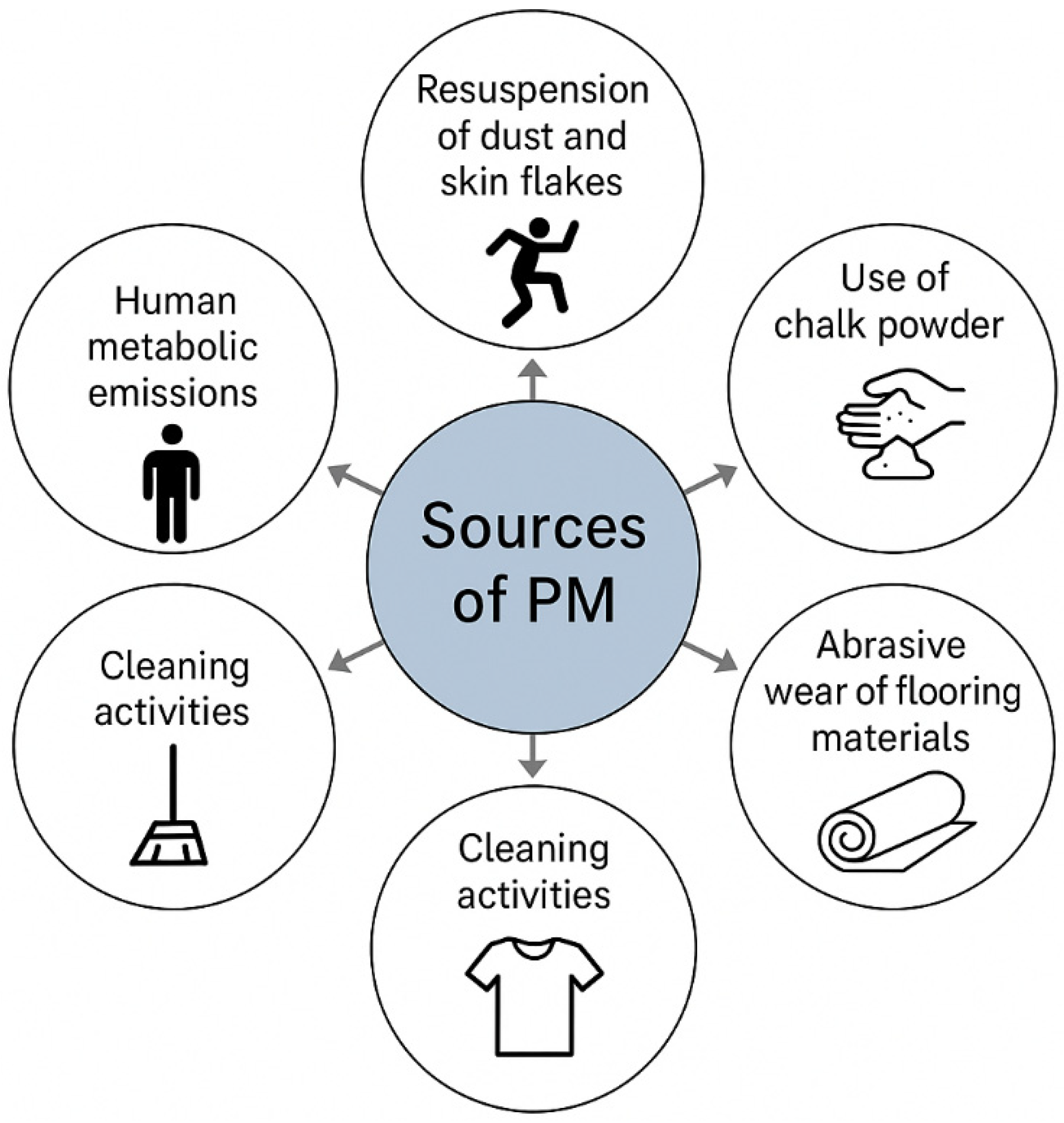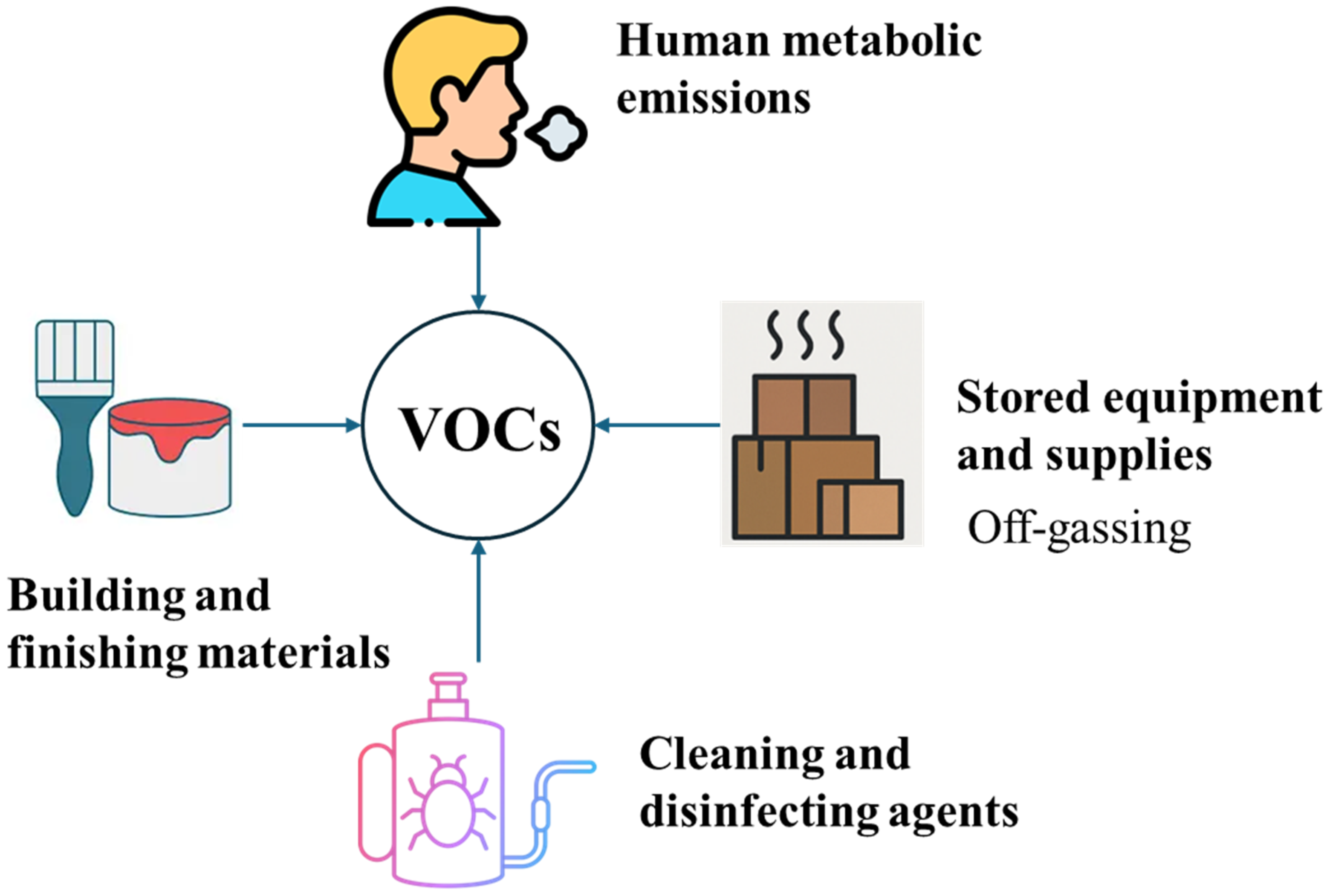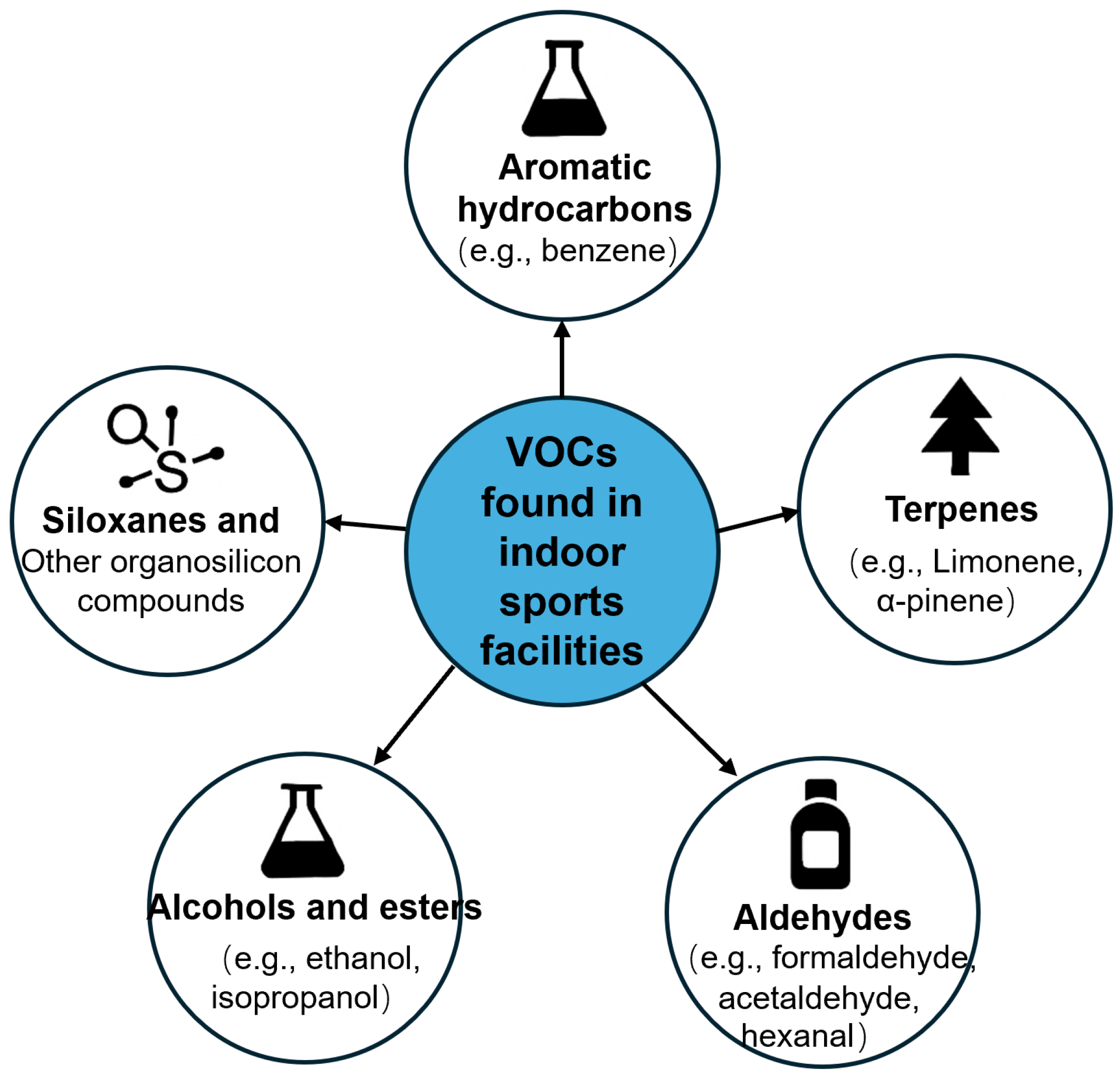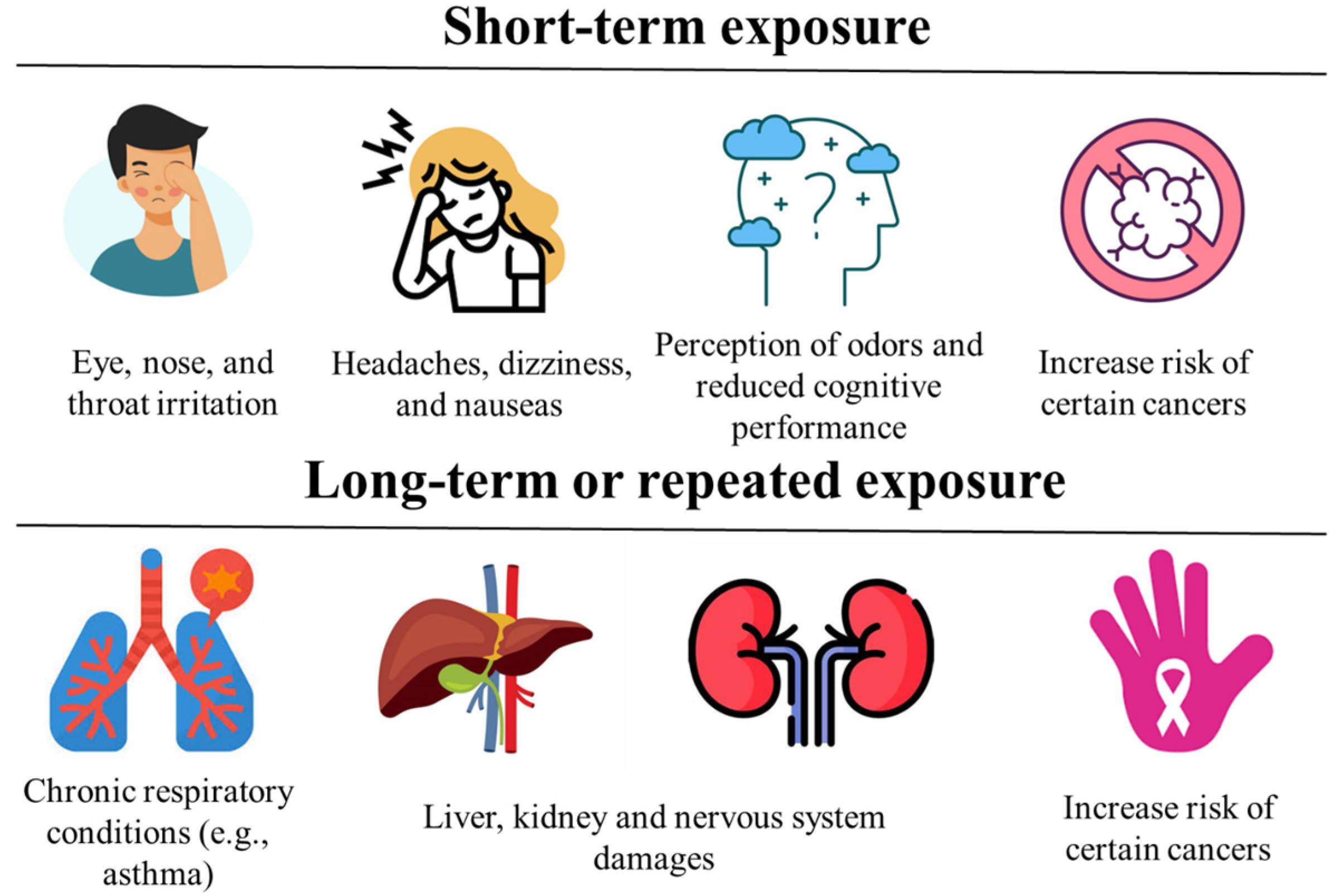Toward Health-Oriented Indoor Air Quality in Sports Facilities: A Narrative Review of Pollutant Dynamics, Smart Control Strategies, and Energy-Efficient Solutions
Abstract
1. Introduction
1.1. General Background
1.2. Literature Gaps and Research Objectives
1.3. Literature Selection Methodology
1.4. Novelty and Structure of the Paper
2. Major Indoor Pollutants in Sports Facilities
2.1. Particulate Matter (PM)
2.2. Chemical Agents
2.2.1. Volatile Organic Compounds (VOCs)
2.2.2. Carbon Dioxide (CO2) as an Indicator of Ventilation Efficiency
2.3. Microbial Pollutants
2.4. Physical Environmental Parameters
- At low RH (<30%), resuspension of PM increases due to reduced adhesion to surfaces and drier dust conditions. This can worsen exposure to PM, especially during intense movement.
- At high RH (>60%), biological pollutants such as mold and bacteria may proliferate, especially on porous surfaces. High humidity also facilitates the aggregation and settling of fine particles, altering their dispersion and inhalation risks.
- RH outside the comfort range (typically 40–60%) may also lead to respiratory tract irritation, eye discomfort, and decreased perceived air quality.
3. Evaluation Methods and Standard Systems for IAQ
3.1. Pollutant Monitoring Techniques
3.2. Comparison of International and Regional Standards
3.3. Health Risk Assessment Models
4. Strategies and Technologies for IAQ Improvement
4.1. Ventilation System Design and Optimization
4.2. Source Control Technologies
4.3. Application of Advanced Purification Technologies
5. Discussion
6. Conclusions
- Indoor sports facilities have distinct IAQ challenges. High occupant density, increased respiration rates, and active body movement significantly increase exposure risks compared to sedentary indoor environments. Common pollutant sources include resuspended particles, magnesium chalk, building material emissions, cleaning agents, and bioaerosols in humid areas.
- Key pollutant categories must be addressed in an integrated way. PM: Highly influenced by activity level; resuspension and chalk use are major sources. Chemical pollutants: VOCs and CO2 levels reflect material selection, occupancy, and ventilation effectiveness. Microbial pollutants: thrive in high-humidity or high-contact zones; lack of regulation in most standards is a concern.
- Physical activity drastically alters exposure dynamics. Inhalation rates during exercise may increase pollutant intake by 4–8 times compared to rest. Risk assessments must incorporate dose-response models linked to activity intensity and duration, particularly for vulnerable groups (e.g., children, athletes, individuals with asthma).
- A multi-tiered strategy is essential for IAQ control. Ventilation: must be optimized for both airflow efficiency and pollutant removal, with zoning and demand-control. Source control: including low-emission materials, cleaner grip agents (e.g., liquid chalk), and humidity regulation, is the most cost-effective prevention method. Advanced purification: HEPA, activated carbon, UV, and photocatalytic systems can supplement ventilation, especially when integrated with real-time monitoring.
- International standards show significant variation and limitations. Most current guidelines do not fully address dynamic, high-exertion environments. China and the US provide relatively sport-aware standards, however, few explicitly consider real-time adaptation or emerging pollutants. Cross-national harmonization and expansion of pollutant categories (e.g., SVOCs, microplastics, DBPs) are needed.
- Post-pandemic expectations are reshaping IAQ design. Users now expect visible air quality indicators, adaptive systems, and evidence of clean air. Hybridized facility usage and irregular occupancy require flexible, smart IAQ solutions. Public trust and operational resilience increasingly depend on how air safety is communicated and managed.
- Future research and development priorities. Develop exposure models accounting for physical activity, age, and environmental variability. Investigate long-term health effects from repeated pollutant exposure in athletic populations. Advance real-time IAQ monitoring and predictive control, integrating environmental sensing with wearable data and AI-based risk management.
- Multidisciplinary collaboration is essential. Effective IAQ solutions require input from building engineers, health experts, policy-makers, data scientists, and facility operators. Standards and regulations must shift from passive compliance to proactive health promotion, especially in spaces dedicated to movement and performance.
Author Contributions
Funding
Data Availability Statement
Acknowledgments
Conflicts of Interest
Abbreviations
| AER | Air exchange rates |
| BMS | Building management systems |
| CO2 | Carbon dioxide |
| DBPs | Disinfection by-products |
| HEPA | High-efficiency particulate air |
| HVAC | Heating ventilating and air-conditioning |
| IAQ | Indoor air quality |
| IR | Inhalation rate |
| LCC | Lifecycle cost |
| LD | Linear dichroism |
| OPC | Optical particle counter |
| O3 | Ozone |
| PID | Photoionization detector |
| PM | Particulate matter |
| PCO | Photocatalytic oxidation |
| ROI | Return on investment |
| SOAs | secondary organic aerosols |
| SVOCs | Semi-volatile organic compounds |
| TiO2 | Titanium dioxide |
| UFPs | Ultrafine particles |
| UV | Ultraviolet |
| UVGI | UV germicidal irradiation |
| VOCs | Volatile organic compounds |
References
- Pan, W.; Turrin, M.; Louter, C.; Sariyildiz, S.; Sun, Y. Integrating multi-functional space and long-span structure in the early design stage of indoor sports arenas by using parametric modelling and multi-objective optimization. J. Build. Eng. 2019, 22, 464–485. [Google Scholar] [CrossRef]
- Heckel, L.; Eime, R.; Karg, A.; McDonald, H.; Yeomans, C.; O’Boyle, I. A systematic review of the wellbeing benefits of being active through leisure and fitness centres. Leis. Leis. Stud. 2024, 43, 545–561. [Google Scholar] [CrossRef]
- Zhong, J.; Liu, W.; Niu, B.; Lin, X.; Deng, Y. Role of Built Environments on Physical Activity and Health Promotion: A Review and Policy Insights. Front. Public Health 2022, 10, 950348. [Google Scholar] [CrossRef] [PubMed]
- Andrade, A.; Dominski, F.H. Indoor air quality of environments used for physical exercise and sports practice: Systematic review. J. Environ. Manag. 2018, 206, 577–586. [Google Scholar] [CrossRef]
- Langhammer, B.; Bergland, A.; Rydwik, E. The Importance of Physical Activity Exercise among Older People. BioMed Res. Int. 2018, 2018, 7856823. [Google Scholar] [CrossRef]
- Kumar, S.; Sakagami, K.; Lee, H.P. Beyond Sustainability: The Role of Regenerative Design in Optimizing Indoor Environmental Quality. Sustainability 2025, 17, 2342. [Google Scholar] [CrossRef]
- Dimitroulopoulou, S.; Dudzińska, M.R.; Gunnarsen, L.; Hägerhed, L.; Maula, H.; Singh, R.; Toyinbo, O.; Haverinen-Shaughnessy, U. Indoor air quality guidelines from across the world: An appraisal considering energy saving, health, productivity, and comfort. Environ. Int. 2023, 178, 108127. [Google Scholar] [CrossRef]
- Zhang, X. The Construction of Urban Public Sports Service from the Perspective of Public Health. Rev. Bras. Med. Esporte 2021, 27, 69–72. [Google Scholar] [CrossRef]
- Qian, F.; Shi, Z.; Yang, L. A Review of Green, Low-Carbon, and Energy-Efficient Research in Sports Buildings. Energies 2024, 17, 4020. [Google Scholar] [CrossRef]
- Silva, B.V.F.; Holm-Nielsen, J.B.; Sadrizadeh, S.; Teles, M.P.R.; Kiani-Moghaddam, M.; Arabkoohsar, A. Sustainable, green, or smart? Pathways for energy-efficient healthcare buildings. Sustain. Cities Soc. 2023, 100, 105013. [Google Scholar] [CrossRef]
- Bralewska, K.; Rogula-Kozłowska, W.; Bralewski, A. Indoor air quality in sports center: Assessment of gaseous pollutants. Build. Environ. 2022, 208, 108589. [Google Scholar] [CrossRef]
- Abu Mansor, A.; Abdullah, S.; Ahmad, A.N.; Ahmed, A.N.; Zulkifli, M.F.R.; Jusoh, S.M.; Ismail, M. Indoor air quality and sick building syndrome symptoms in administrative office at public university. Dialogues Health 2024, 4, 100178. [Google Scholar] [CrossRef] [PubMed]
- Zhang, D.; Ortiz, M.A.; Bluyssen, P.M. A review on indoor environmental quality in sports facilities: Indoor air quality and ventilation during a pandemic. Indoor Built Environ. 2022, 32, 831–851. [Google Scholar] [CrossRef]
- Fantozzi, F.; Lamberti, G. Determination of Thermal Comfort in Indoor Sport Facilities Located in Moderate Environments: An Overview. Atmosphere 2019, 10, 769. [Google Scholar] [CrossRef]
- Hulteen, R.M.; Smith, J.J.; Morgan, P.J.; Barnett, L.M.; Hallal, P.C.; Colyvas, K.; Lubans, D.R. Global participation in sport and leisure-time physical activities: A systematic review and meta-analysis. Prev. Med. 2017, 95, 14–25. [Google Scholar] [CrossRef]
- Du, F.; Wang, J.; Mao, L.; Kang, J. Daily rhythm of urban space usage: Insights from the nexus of urban functions and human mobility. Humanit. Soc. Sci. Commun. 2024, 11, 49. [Google Scholar] [CrossRef]
- Shi, Y.; Lian, Z.; Hu, S.; Hu, Y. How does indoor environment affect people’s comfort and exercise performance in sports buildings? Sci. Technol. Built Environ. 2024, 30, 194–206. [Google Scholar] [CrossRef]
- Wergeland, E.S.; Hognestad, H.K. Reusing Stadiums for a Greener Future: The Circular Design Potential of Football Architecture. Front. Sports Act. Living 2021, 3, 692632. [Google Scholar] [CrossRef]
- Boonrattanakij, N.; Yomchinda, S.; Lin, F.-J.; Bellotindos, L.M.; Lu, M.-C. Investigation and disinfection of bacteria and fungi in sports fitness center. Environ. Sci. Pollut. Res. 2021, 28, 52576–52586. [Google Scholar] [CrossRef]
- Karaiskos, P.; Martinez-Molina, A.; Alamaniotis, M. Analyzing indoor air pollutants in naturally ventilated athletic facilities. A case of study. J. Build. Eng. 2023, 77, 107457. [Google Scholar] [CrossRef]
- Vihanninjoki, V. Real-Time Indoor Environment Quality Assessment of Sports Facilities. Master’s Thesis, Aalto University, Espoo, Finland, 2023. [Google Scholar]
- Domingo, J.L.; Marquès, M.; Rovira, J. Influence of airborne transmission of SARS-CoV-2 on COVID-19 pandemic. A review. Environ. Res. 2020, 188, 109861. [Google Scholar] [CrossRef]
- Grande, M.S.; Cao, G. Air Quality in Sport Facilities. E3S Web Conf. 2019, 111, 02023. [Google Scholar] [CrossRef]
- Liu, L.; Ma, Y.; Huang, R.; Lin, S.; Jia, M.; Liu, G.; Zheng, W. An empirical study of indoor air quality in badminton stadiums in hot summer and cold winter regions of China during spring and fall seasons. Sci. Rep. 2024, 14, 3427. [Google Scholar] [CrossRef] [PubMed]
- GB/T 18883-2022; Standards for Indoor Air Quality. State Administration for Market Regulation (SAMR). Standardization Administration of China (SAC): Beijing, China, 2022.
- Sundell, J.; Levin, H.; Nazaroff, W.W.; Cain, W.S.; Fisk, W.J.; Grimsrud, D.T.; Gyntelberg, F.; Li, Y.; Persily, A.K.; Pickering, A.C.; et al. Ventilation rates and health: Multidisciplinary review of the scientific literature. Indoor Air 2011, 21, 191–204. [Google Scholar] [CrossRef] [PubMed]
- EN 16798-1:2019; Energy Performance of Buildings—Ventilation for Buildings—Indoor Environmental Input Parameters for Design and Assessment of Energy Performance of Buildings Addressing Indoor Air Quality, Thermal Environment, Lighting and Acoustics—Part 1: Indoor Environmental Input Parameters for Design and Assessment of Energy Performance of Buildings. European Committee for Standardization (CEN): Brussels, Belgium, 2019. Available online: https://standards.cencenelec.eu (accessed on 5 March 2025).
- Rodgers, M.; Sowden, A.; Petticrew, M.; Arai, L.; Roberts, H.; Britten, N.; Popay, J. Testing Methodological Guidance on the Conduct of Narrative Synthesis in Systematic Reviews. Evaluation 2009, 15, 49–73. [Google Scholar] [CrossRef]
- Elsevier. Mendeley Reference Manager (Version 2.135.0). 2025. Available online: https://www.mendeley.com (accessed on 10 July 2025).
- Chauhan, B.V.S.; Corada, K.; Young, C.; Smallbone, K.L.; Wyche, K.P. Review on Sampling Methods and Health Impacts of Fine (PM2.5, ≤2.5 µm) and Ultrafine (UFP, PM0.1, ≤0.1 µm) Particles. Atmosphere 2024, 15, 572. [Google Scholar] [CrossRef]
- Khan, S.; Gurjar, B.R.; Sahu, V. Deposition modeling of ambient particulate matter in the human respiratory tract. Atmospheric Pollut. Res. 2022, 13, 101565. [Google Scholar] [CrossRef]
- Moreno-Ríos, A.L.; Tejeda-Benítez, L.P.; Bustillo-Lecompte, C.F. Sources, characteristics, toxicity, and control of ultrafine particles: An overview. Geosci. Front. 2022, 13, 101147. [Google Scholar] [CrossRef]
- Torkmahalleh, M.A.; Kabay, K.; Bazhanova, M.; Mohiuddin, O.; Obaidullah, M.; Gorjinezhad, S. Investigating the impact of different sport trainings on particulate matter resuspension in a sport center using well-characterized reference instruments and a low-cost monitor. Sci. Total. Environ. 2018, 612, 957–965. [Google Scholar] [CrossRef]
- Bralewska, K.; Rogula-Kozłowska, W. Health exposure of users of indoor sports centers related to the physico-chemical properties of particulate matter. Build. Environ. 2020, 180, 106935. [Google Scholar] [CrossRef]
- Uhde, E.; Salthammer, T. Impact of reaction products from building materials and furnishings on indoor air quality—A review of recent advances in indoor chemistry. Atmos. Environ. 2007, 41, 3111–3128. [Google Scholar] [CrossRef]
- Sarwar, G.; Corsi, R. The effects of ozone/limonene reactions on indoor secondary organic aerosols. Atmos. Environ. 2007, 41, 959–973. [Google Scholar] [CrossRef]
- Zhou, L.; Liu, G.; Shen, M.; Liu, Y.; Lam, P.K.S. Characteristics of indoor dust in an industrial city: Comparison with outdoor dust and atmospheric particulates. Chemosphere 2021, 272, 129952. [Google Scholar] [CrossRef]
- Khaki, S.; Rio, M. Marin, Monitoring Indoor Air Quality in Additive Manufacturing environment. Procedia CIRP 2020, 90, 455–460. [Google Scholar] [CrossRef]
- Nehr, S.; Duarte, R.M.B.O.; Almeida, A.S.; Baus, L.; Bergmann, K.-C. Assessing the relevance of allergenic pollen in indoor environments—Current knowledge base and research needs. Allergo J. Int. 2023, 32, 167–175. [Google Scholar] [CrossRef] [PubMed]
- Telford, D.M.; Meiring, R.M.; Gusso, S. Moving beyond moderate-to-vigorous physical activity: A longitudinal study on adherence to 24-hour Movement Guidelines in adolescents. J. Sci. Med. Sport 2024, 28, 147–153. [Google Scholar] [CrossRef]
- Kek, H.Y.; Tan, H.; Othman, M.H.D.; Nyakuma, B.B.; Goh, P.S.; Wong, S.L.; Deng, X.; Leng, P.C.; Yatim, A.S.; Wong, K.Y. Perspectives on human movement considerations in indoor airflow assessment: A comprehensive data-driven systematic review. Environ. Sci. Pollut. Res. 2023, 30, 121253–121268. [Google Scholar] [CrossRef] [PubMed]
- Ashley, A. Chalk Dust: Mitigation & Source Control. CWA Blog. Available online: https://www.cwapro.org/blog/chalk-dust-mitigation-and-source-control (accessed on 1 April 2025).
- Weinbruch, S.; Dirsch, T.; Ebert, M.; Hofmann, H.; Kandler, K. Dust exposure in indoor climbing halls. J. Environ. Monit. 2008, 10, 648–654. [Google Scholar] [CrossRef]
- Liang, W.-M.; Ji, Y.-X.; Xiao, J.; Truskauskaitė, I.; Hendrixson, A.; Bai, Z.-M.; Ruksenas, O. Respiratory patterns and physical fitness in healthy adults: A cross-sectional study. BMC Public Health 2024, 24, 228. [Google Scholar] [CrossRef]
- Ramos, C.A.; Wolterbeek, H.T.; Almeida, S.M. Exposure to indoor air pollutants during physical activity in fitness centers. Build. Environ. 2014, 82, 349–360. [Google Scholar] [CrossRef]
- Kim, K.-H.; Kabir, E.; Kabir, S. A review on the human health impact of airborne particulate matter. Environ. Int. 2015, 74, 136–143. [Google Scholar] [CrossRef] [PubMed]
- Slezakova, K.; Peixoto, C.; Oliveira, M.; Delerue-Matos, C.; Pereira, M.D.C.; Morais, S. Indoor particulate pollution in fitness centres with emphasis on ultrafine particles. Environ. Pollut. 2018, 233, 180–193. [Google Scholar] [CrossRef] [PubMed]
- Araneda, O.F.; Kosche-Cárcamo, F.; Verdugo-Marchese, H.; Tuesta, M. Pulmonary Effects Due to Physical Exercise in Polluted Air: Evidence from Studies Conducted on Healthy Humans. Appl. Sci. 2021, 11, 2890. [Google Scholar] [CrossRef]
- Nieckarz, Z.; Pawlak, K.; Zoladz, J.A. Health risks for children exercising in an air-polluted environment can be reduced by monitoring air quality with low-cost particle sensors. Sci. Rep. 2023, 13, 18261. [Google Scholar] [CrossRef]
- United States Environmental Protection Agency. What Are Volatile Organic Compounds (VOCs)? Available online: https://www.epa.gov/indoor-air-quality-iaq/volatile-organic-compounds-impact-indoor-air-quality (accessed on 10 April 2025).
- Alves, C.A.; Calvo, A.I.; Castro, A.; Fraile, R.; Evtyugina, M.; Bate-Epey, E.F. Indoor Air Quality in Two University Sports Facilities. Aerosol Air Qual. Res. 2013, 13, 1723–1730. [Google Scholar] [CrossRef]
- Szulc, J.; Okrasa, M.; Ryngajłło, M.; Pielech-Przybylska, K.; Gutarowska, B. Markers of Chemical and Microbiological Contamination of the Air in the Sport Centers. Molecules 2023, 28, 3560. [Google Scholar] [CrossRef]
- Finewax, Z.; Pagonis, D.; Claflin, M.S.; Handschy, A.V.; Brown, W.L.; Jenks, O.; Nault, B.A.; Day, D.A.; Lerner, B.M.; Jimenez, J.L.; et al. Quantification and source characterization of volatile organic compounds from exercising and application of chlorine-based cleaning products in a university athletic center. Indoor Air 2020, 31, 1323–1339. [Google Scholar] [CrossRef]
- Wolkoff, P.; Nielsen, G.D. Organic compounds in indoor air—Their relevance for perceived indoor air quality? Atmos. Environ. 2001, 35, 4407–4417. [Google Scholar] [CrossRef]
- Jones, A. Indoor air quality and health. Atmos. Environ. 1999, 33, 4535–4564. [Google Scholar] [CrossRef]
- International Agency for Research on Cancer (IARC). Formaldehyde, 2-Butoxyethanol and 1-tert-Butoxypropan-2-ol. IARC Monographs on the Evaluation of Carcinogenic Risks to Humans. 2006. Available online: https://www.ncbi.nlm.nih.gov/books/NBK326468/pdf/Bookshelf_NBK326468.pdf (accessed on 12 April 2025).
- World Health Organization (WHO). WHO Guidelines for Indoor Air Quality: Selected Pollutants. 2010. Available online: https://www.who.int/publications/i/item/9789289002134 (accessed on 12 April 2025).
- Persily, A.; de Jonge, L. Carbon dioxide generation rates for building occupants. Indoor Air 2017, 27, 868–879. [Google Scholar] [CrossRef]
- Satish, U.; Mendell, M.J.; Shekhar, K.; Hotchi, T.; Sullivan, D.; Streufert, S.; Fisk, W.J. Is CO2 an Indoor Pollutant? Direct Effects of Low-to-Moderate CO2 Concentrations on Human Decision-Making Performance. Environ. Health Perspect. 2012, 120, 1671–1677. [Google Scholar] [CrossRef]
- Atalay, A.; Švagždienė, B. Sustainable Environment Problems Arising from Sports Facilities. Laisval. Tyrim. 2023, 1, 1–15. [Google Scholar] [CrossRef]
- Dominelli, P.B.; Sheel, A.W. The pulmonary physiology of exercise. Adv. Physiol. Educ. 2024, 48, 238–251. [Google Scholar] [CrossRef] [PubMed]
- Seppanen, O.A.; Fisk, W.J.; Mendell, M.J. Association of Ventilation Rates and CO2 Concentrations with Health andOther Responses in Commercial and Institutional Buildings. Indoor Air 1999, 9, 226–252. [Google Scholar] [CrossRef] [PubMed]
- Lunden, M.M.; Delp, W.W.; Singer, B.C. Capture efficiency of cooking-related fine and ultrafine particles by residential exhaust hoods. Indoor Air 2014, 25, 45–58. [Google Scholar] [CrossRef] [PubMed]
- ANSI/ASHRAE Standard 62.1-2022; Ventilation for Acceptable Indoor Air Quality. American Society of Heating, Refrigerating and Air-Conditioning Engineers (ASHRAE): Peachtree Corners, GA, USA, 2022. Available online: https://www.ashrae.org/technical-resources/bookstore/standards-62-1-62-2 (accessed on 18 April 2025).
- Emmerich, S.J.; Persily, A.K. State-of-the-Art Review of CO2 Demand Controlled Ventilation Technology and Application; National Institute of Standards and Technology: Gaithersburg, MD, USA, 2001. [Google Scholar] [CrossRef]
- Fisk, W.J.; Lei-Gomez, Q.; Mendell, M.J. Meta-analyses of the associations of respiratory health effects with dampness and mold in homes. Indoor Air 2007, 17, 284–296. [Google Scholar] [CrossRef]
- Eduard, W. Fungal spores: A critical review of the toxicological and epidemiological evidence as a basis for occupational exposure limit setting. Crit. Rev. Toxicol. 2009, 39, 799–864. [Google Scholar] [CrossRef]
- Batterman, S. Review and Extension of CO2-Based Methods to Determine Ventilation Rates with Application to School Classrooms. Int. J. Environ. Res. Public Health 2017, 14, 145. [Google Scholar] [CrossRef]
- Gupta, J.K.; Lin, C.-H.; Chen, Q. Risk assessment of airborne infectious diseases in aircraft cabins. Indoor Air 2012, 22, 388–395. [Google Scholar] [CrossRef]
- Leung, M.H.Y.; Lee, P.K.H. The roles of the outdoors and occupants in contributing to a potential pan-microbiome of the built environment: A review. Microbiome 2016, 4, 21. [Google Scholar] [CrossRef]
- Hospodsky, D.; Qian, J.; Nazaroff, W.W.; Yamamoto, N.; Bibby, K.; Rismani-Yazdi, H.; Peccia, J.; Wold, L.E. Human Occupancy as a Source of Indoor Airborne Bacteria. PLoS ONE 2012, 7, e34867. [Google Scholar] [CrossRef]
- Meadow, J.F.; Altrichter, A.E.; Green, J.L. Mobile phones carry the personal microbiome of their owners. PeerJ 2014, 2, e447. [Google Scholar] [CrossRef] [PubMed]
- Adams, R.I.; Miletto, M.; Taylor, J.W.; Bruns, T.D. Dispersal in microbes: Fungi in indoor air are dominated by outdoor air and show dispersal limitation at short distances. ISME J. 2013, 7, 1262–1273. [Google Scholar] [CrossRef] [PubMed]
- Ramos, C.A.; Viegas, C.; Verde, S.C.; Wolterbeek, H.T.; Almeida, S.M. Characterizing the fungal and bacterial microflora and concentrations in fitness centres. Indoor Built Environ. 2016, 25, 872–882. [Google Scholar] [CrossRef]
- Mendell, M.J.; Mirer, A.G.; Cheung, K.; Tong, M.; Douwes, J. Respiratory and Allergic Health Effects of Dampness, Mold, and Dampness-Related Agents: A Review of the Epidemiologic Evidence. Environ. Heal. Perspect. 2011, 119, 748–756. [Google Scholar] [CrossRef]
- Institute of Medicine (US) Committee on Damp Indoor Spaces and Health. Damp Indoor Spaces and Health; National Academies Press: Washington, DC, USA, 2004. [Google Scholar] [CrossRef]
- Girard, M.; Israël-Assayag, E.; Cormier, Y. Pathogenesis of hypersensitivity pneumonitis. Curr. Opin. Allergy Clin. Immunol. 2004, 4, 93–98. [Google Scholar] [CrossRef]
- Prussin, A.J.; Marr, L.C. Sources of airborne microorganisms in the built environment. Microbiome 2015, 3, 78. [Google Scholar] [CrossRef]
- Douwes, J.; Thorne, P.; Pearce, N.; Heederik, D. Bioaerosol Health Effects and Exposure Assessment: Progress and Prospects. Ann. Occup. Hyg. 2003, 47, 187–200. [Google Scholar] [CrossRef]
- Parsons, K. Human Thermal Environments, 3rd ed.; CRC Press: Boca Raton, FL, USA, 2002. [Google Scholar] [CrossRef]
- Miletić, M.; Komatina, D.; Babić, L.; Lukić, J. Evaluating Energy Retrofit and Indoor Environmental Quality in a Serbian Sports Facility: A Comprehensive Case Study. Appl. Sci. 2024, 14, 9401. [Google Scholar] [CrossRef]
- Luongo, J.C.; Fennelly, K.P.; Keen, J.A.; Zhai, Z.J.; Jones, B.W.; Miller, S.L. Role of mechanical ventilation in the airborne transmission of infectious agents in buildings. Indoor Air 2015, 26, 666–678. [Google Scholar] [CrossRef]
- Nazaroff, W.W. Indoor particle dynamics. Indoor Air 2004, 14, 175–183. [Google Scholar] [CrossRef]
- Weschler, C.J.; Nazaroff, W.W. SVOC exposure indoors: Fresh look at dermal pathways. Indoor Air 2012, 22, 356–377. [Google Scholar] [CrossRef]
- Casa, D.J.; Armstrong, L.E.; Hillman, S.K.; Montain, S.J.; Reiff, R.V.; Rich, B.S.; Roberts, W.O.; Stone, J.A. National Athletic Trainers’ Association Position Statement: Fluid Replacement for Athletes. J. Athl. Train. 2000, 35, 212–224. [Google Scholar] [PubMed]
- ASHRAE. ASHRAE-Fundamental-Handbook; ASHRAE: Atlanta, GA, USA, 2001. [Google Scholar]
- Fanger, P.O. Thermal Comfort: Analysis and Applications in Environmental Engineering; Danish Technical Press: Copenhagen, Denmark, 1970. [Google Scholar]
- EN ISO 7730; Ergonomics of the Thermal Environment—Analytical Determination and Interpretation of Thermal Comfort Using PMV and PPD Indices. ISO: Geneva, Switzerland, 2005.
- Castell, N.; Dauge, F.R.; Schneider, P.; Vogt, M.; Lerner, U.; Fishbain, B.; Broday, D.; Bartonova, A. Can commercial low-cost sensor platforms contribute to air quality monitoring and exposure estimates? Environ. Int. 2017, 99, 293–302. [Google Scholar] [CrossRef] [PubMed]
- Weschler, C.J. Changes in indoor pollutants since the 1950s. Atmos. Environ. 2009, 43, 153–169. [Google Scholar] [CrossRef]
- Marques, G.; Saini, J.; Dutta, M.; Singh, P.K.; Hong, W.-C. Indoor Air Quality Monitoring Systems for Enhanced Living Environments: A Review toward Sustainable Smart Cities. Sustainability 2020, 12, 4024. [Google Scholar] [CrossRef]
- Braniš, M.; Šafránek, J. Characterization of coarse particulate matter in school gyms. Environ. Res. 2011, 111, 485–491. [Google Scholar] [CrossRef]
- Undavalli, V.K.; Khandelwal, B. Impact of Alternative Fuels and Fuel Properties on PM Emissions. In Aviation Fuels; Elsevier: Amsterdam, The Netherlands, 2021; pp. 71–111. [Google Scholar] [CrossRef]
- Bílek, J.; Maršolek, P.; Bílek, O.; Buček, P. Field Test of Mini Photoionization Detector-Based Sensors—Monitoring of Volatile Organic Pollutants in Ambient Air. Environments 2022, 9, 49. [Google Scholar] [CrossRef]
- Małecka-Adamowicz, M.; Kubera, Ł.; Jankowiak, E.; Dembowska, E. Microbial diversity of bioaerosol inside sports facilities and antibiotic resistance of isolated Staphylococcus spp. Aerobiologia 2019, 35, 731–742. [Google Scholar] [CrossRef]
- Di Bella, J.M.; Bao, Y.; Gloor, G.B.; Burton, J.P.; Reid, G. High throughput sequencing methods and analysis for microbiome research. J. Microbiol. Methods 2013, 95, 401–414. [Google Scholar] [CrossRef]
- Godefrog, J. CIBSE TM40—Health and Wellbeing in Building Services; Chartered Institution of Building Services Engineers (CIBSE): London, UK, 2020; ISBN 9781912034505. [Google Scholar]
- U.S. Environmental Protection Agency. Risk Assessment Guidance for Superfund (RAGS): Volume I—Human Health Evaluation Manual (Part F). 2009. Available online: https://www.epa.gov/risk/risk-assessment-guidance-superfund-rags-part-f (accessed on 25 April 2025).
- U.S. EPA. Exposure Factors Handbook 2011 Edition (Final Report); United States Environmental Protection Agency: Washington, DC, USA, 2011. Available online: https://cfpub.epa.gov/ncea/risk/recordisplay.cfm?deid=236252 (accessed on 25 April 2025).
- Carlisle, A.J.; Sharp, N.C.C. Exercise and outdoor ambient air pollution. Br. J. Sports Med. 2001, 35, 214–222. [Google Scholar] [CrossRef]
- Chatzidiakou, L.; Mumovic, D.; Summerfield, A. Is CO2 a good proxy for indoor air quality in classrooms? Part 2: Health outcomes and perceived indoor air quality in relation to classroom exposure and building characteristics. Build. Serv. Eng. Res. Technol. 2015, 36, 162–181. [Google Scholar] [CrossRef]
- Paterson, C.A.; Sharpe, R.A.; Taylor, T.; Morrissey, K. Indoor PM2.5, VOCs and asthma outcomes: A systematic review in adults and their home environments. Environ. Res. 2021, 202, 111631. [Google Scholar] [CrossRef] [PubMed]
- Morawska, L.; Tang, J.W.; Bahnfleth, W.; Bluyssen, P.M.; Boerstra, A.; Buonanno, G.; Cao, J.; Dancer, S.; Floto, A.; Franchimon, F.; et al. How can airborne transmission of COVID-19 indoors be minimised? Environ. Int. 2020, 142, 105832. [Google Scholar] [CrossRef] [PubMed]
- Daikin. What Requirements do HVAC Systems Need to Meet in Modern Stadiums? Available online: https://www.daikin-ce.com/en_us/daikin-blog/needs-hvac-systems-are-required-to-meet-in-stadiums.html (accessed on 30 April 2025).
- Hurnik, M.; Ferdyn-Grygierek, J.; Kaczmarczyk, J.; Koper, P. Thermal Diagnosis of Ventilation and Cooling Systems in a Sports Hall—A Case Study. Buildings 2023, 13, 1185. [Google Scholar] [CrossRef]
- ASHRAE. Ventilation and Indoor Air Quality Requirements. 2019. Available online: https://energycodeace.com/site/custom/public/reference-ace-2019/Documents/43ventilationandindoorairqualityrequirements.htm (accessed on 30 April 2025).
- Cao, G.; Awbi, H.; Yao, R.; Fan, Y.; Sirén, K.; Kosonen, R.; Zhang, J. A review of the performance of different ventilation and airflow distribution systems in buildings. Build. Environ. 2014, 73, 171–186. [Google Scholar] [CrossRef]
- Heiselberg, P. IEA ECBCS Annex 35 Final Report. In Principles of Hybrid Ventilation IEA Energy Conservation in Buildings and Community Systems Programme Annex 35: Hybrid Ventilation in New and Retrofitted Office Buildings; Aalborg University: Aalborg, Denmark, 2002; Available online: https://iea-ebc.org/Data/publications/EBC_Annex_35_Principles_of_H_V.pdf (accessed on 30 April 2025).
- International Energy Agency (IEA). Control Strategies for Hybrid Ventilation in New and Retrofitted Office Buildings. 2006. Available online: https://www.iea-ebc.org/Data/publications/EBC_Annex_35_tsr.pdf (accessed on 5 May 2025).
- Seppanen, O.A.; Fisk, W.J. Summary of human responses to ventilation. Indoor Air 2004, 14 (Suppl. S7), 102–118. [Google Scholar] [CrossRef]
- Dobbs, J.R.; Hencey, B.M. Model Predictive HVAC Control with Online Occupancy Model. Energy Build. 2014, 82, 675–684. [Google Scholar] [CrossRef]
- Kim, J. LSTM-based Space Occupancy Prediction towards Efficient Building Energy Management. arXiv 2020, arXiv:2012.08114. [Google Scholar] [CrossRef]
- Melikov, A.K. Personalized ventilation. Indoor Air 2004, 14, 157–167. [Google Scholar] [CrossRef]
- Yang, Y.; Wang, Y.; Yuan, X.; Zhu, Y.; Zhang, D. Simulation study on the thermal environment in an office with radiant cooling and displacement ventilation system. Procedia Eng. 2017, 205, 3146–3153. [Google Scholar] [CrossRef]
- Krajčík, M.; Tomasi, R.; Simone, A.; Olesen, B.W. Experimental study including subjective evaluations of mixing and displacement ventilation combined with radiant floor heating/cooling system. HVACR Res. 2013, 19, 1063–1072. [Google Scholar] [CrossRef]
- U.S. EPA. Introduction to Indoor Air Quality. 2023. Available online: https://www.epa.gov/indoor-air-quality-iaq/introduction-indoor-air-quality (accessed on 15 May 2025).
- UL GREENGUARD. REENGUARD Certification Program. Available online: https://www.ul.com/resources/ul-greenguard-certification-program (accessed on 15 May 2025).
- GB/T 35602-2017; Guideline for the Control of Indoor Decoration Materials Emission of Volatile Organic Compounds. TC5: Changzhou, China, 2017. Available online: https://openstd.samr.gov.cn (accessed on 15 May 2025).
- Wolkoff, P. Indoor air humidity, air quality, and health—An overview. Int. J. Hyg. Environ. Health 2018, 221, 376–390. [Google Scholar] [CrossRef] [PubMed]
- Weinbruch, S.; Dirsch, T.; Kandler, K.; Ebert, M.; Heimburger, G.; Hohenwarter, F. Reducing dust exposure in indoor climbing gyms. J. Environ. Monit. 2012, 14, 2114–2120. [Google Scholar] [CrossRef] [PubMed]
- Arundel, A.V.; Sterling, E.M.; Biggin, J.H.; Sterling, T.D. Indirect health effects of relative humidity in indoor environments. Environ. Health Perspect. 1986, 65, 351–361. [Google Scholar] [CrossRef]
- Kao, J.-J.; Hsieh, M.-R. Utilizing multiobjective analysis to determine an air quality monitoring network in an industrial district. Atmos. Environ. 2006, 40, 1092–1103. [Google Scholar] [CrossRef]
- Elnour, M.; Fadli, F.; Himeur, Y.; Petri, I.; Rezgui, Y.; Meskin, N.; Ahmad, A.M. Performance and energy optimization of building automation and management systems: Towards smart sustainable carbon-neutral sports facilities. Renew. Sustain. Energy Rev. 2022, 162, 112401. [Google Scholar] [CrossRef]
- European Standard EN 1822-1:2009; High Efficiency Air Filters (EPA, HEPA and ULPA). Slovenian Institute for Standardization (SIST): Ljubljana, Slovenia, 2009.
- United States Environmental Protection Agency. What Is a HEPA Filter? Available online: https://www.epa.gov/indoor-air-quality-iaq/what-hepa-filter (accessed on 23 May 2025).
- Salonen, H.; Salthammer, T.; Morawska, L. Human exposure to air contaminants in sports environments. Indoor Air 2020, 30, 1109–1129. [Google Scholar] [CrossRef]
- What Does a Carbon Filter Do? What Is a Carbon Filter? Available online: https://www.iso-aire.com/blog/carbon-filters-air-purification-odor-fume-vocs-relief#:~:text=Carbon%20Filters%20Reduce%20Fumes%20and,be%20detrimental%20to%20occupant%20health (accessed on 23 May 2025).
- Mamaghani, A.H.; Haghighat, F.; Lee, C.-S. Photocatalytic oxidation technology for indoor environment air purification: The state-of-the-art. Appl. Catal. B Environ. 2017, 203, 247–269. [Google Scholar] [CrossRef]
- Li, Y.-W.; Ma, W.-L. Photocatalytic oxidation technology for indoor air pollutants elimination: A review. Chemosphere 2021, 280, 130667. [Google Scholar] [CrossRef]
- Weschler, C.J. Ozone’s Impact on Public Health: Contributions from Indoor Exposures to Ozone and Products of Ozone-Initiated Chemistry. Environ. Heal. Perspect. 2006, 114, 1489–1496. [Google Scholar] [CrossRef] [PubMed]
- Kowalski, W. UVGI Disinfection Theory. In Ultraviolet Germicidal Irradiation Handbook; Springer: Berlin/Heidelberg, Germany, 2009; pp. 17–50. [Google Scholar] [CrossRef]
- Mphaphlele, M.; Dharmadhikari, A.S.; Jensen, P.A.; Rudnick, S.N.; van Reenen, T.H.; Pagano, M.A.; Leuschner, W.; Sears, T.A.; Milonova, S.P.; van der Walt, M.; et al. Institutional Tuberculosis Transmission. Controlled Trial of Upper Room Ultraviolet Air Disinfection: A Basis for New Dosing Guidelines. Am. J. Respir. Crit. Care Med. 2015, 192, 477–484. [Google Scholar] [CrossRef] [PubMed]
- Zhang, Y.; Mo, J.; Li, Y.; Sundell, J.; Wargocki, P.; Zhang, J.; Little, J.C.; Corsi, R.; Deng, Q.; Leung, M.H.; et al. Can commonly-used fan-driven air cleaning technologies improve indoor air quality? A literature review. Atmos. Environ. 2011, 45, 4329–4343. [Google Scholar] [CrossRef] [PubMed]
- Yu, L.; Xie, D.; Huang, C.; Jiang, T.; Zou, Y. Energy Optimization of HVAC Systems in Commercial Buildings Considering Indoor Air Quality Management. IEEE Trans. Smart Grid 2018, 10, 5103–5113. [Google Scholar] [CrossRef]
- Mistry, V. Impact of Building Automation on Indoor Air Quality and HVAC Performance. J. Artif. Intell. Cloud Comput. 2023, 2, 1–4. [Google Scholar] [CrossRef]
- Mishra, A.K.; Tartarini, F.; Sultan, Z.; Schiavon, S. Automated decontamination of workspaces using UVC coupled with occupancy detection. arXiv 2021, arXiv:2101.12581. [Google Scholar] [CrossRef]
- Luo, H.; Zhong, L. Ultraviolet germicidal irradiation (UVGI) for in-duct airborne bioaerosol disinfection: Review and analysis of design factors. Build. Environ. 2021, 197, 107852. [Google Scholar] [CrossRef]
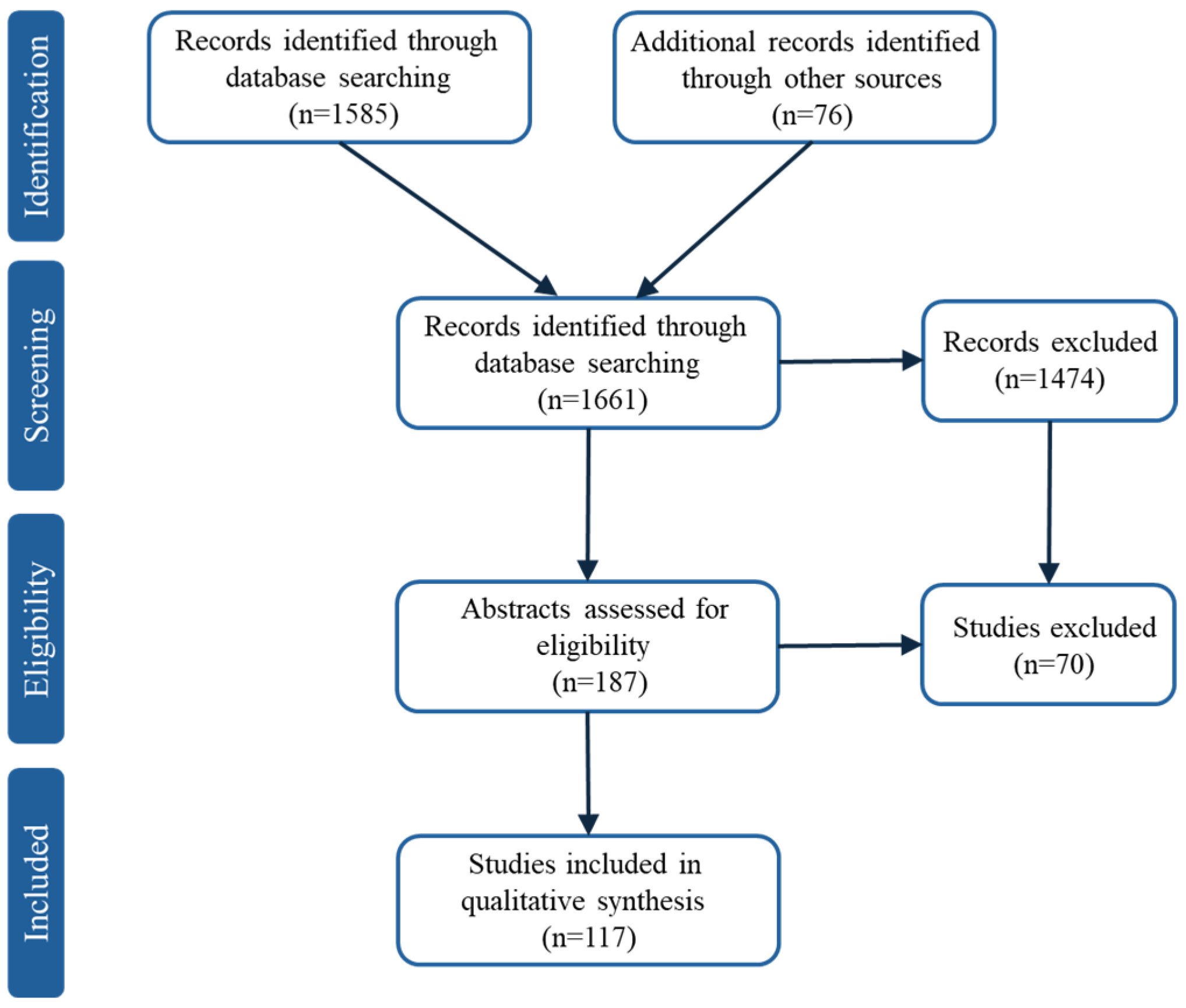
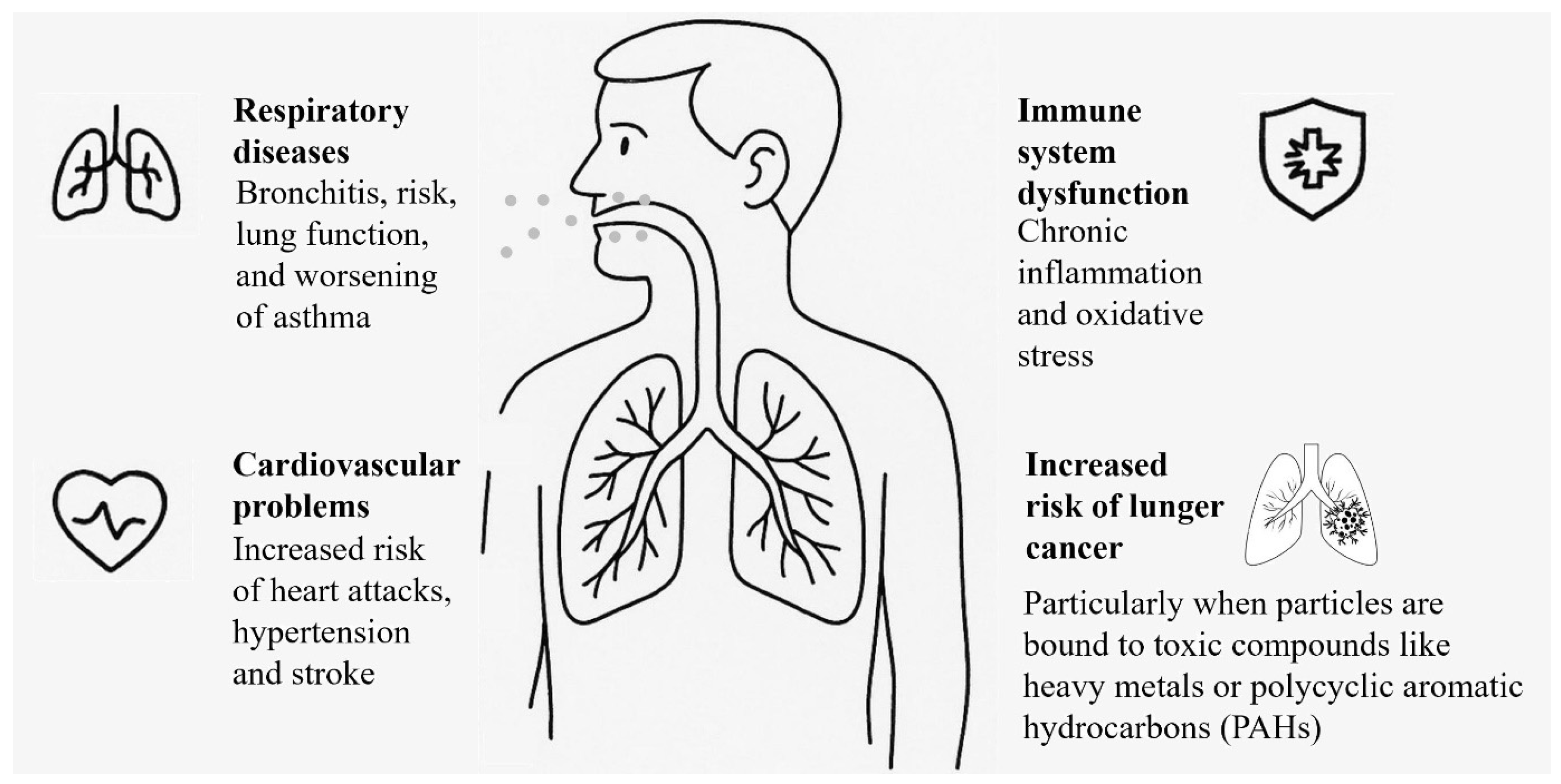
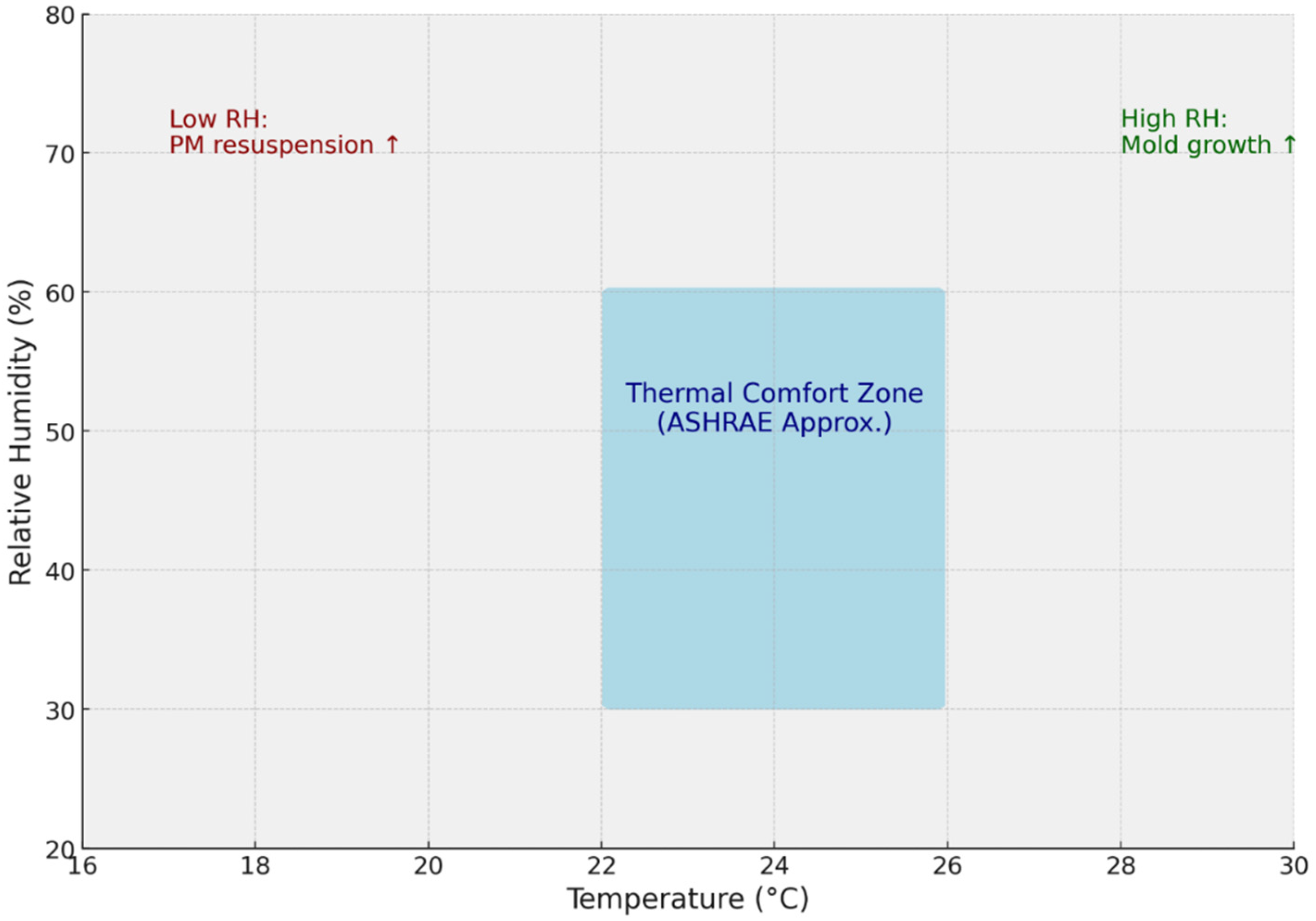

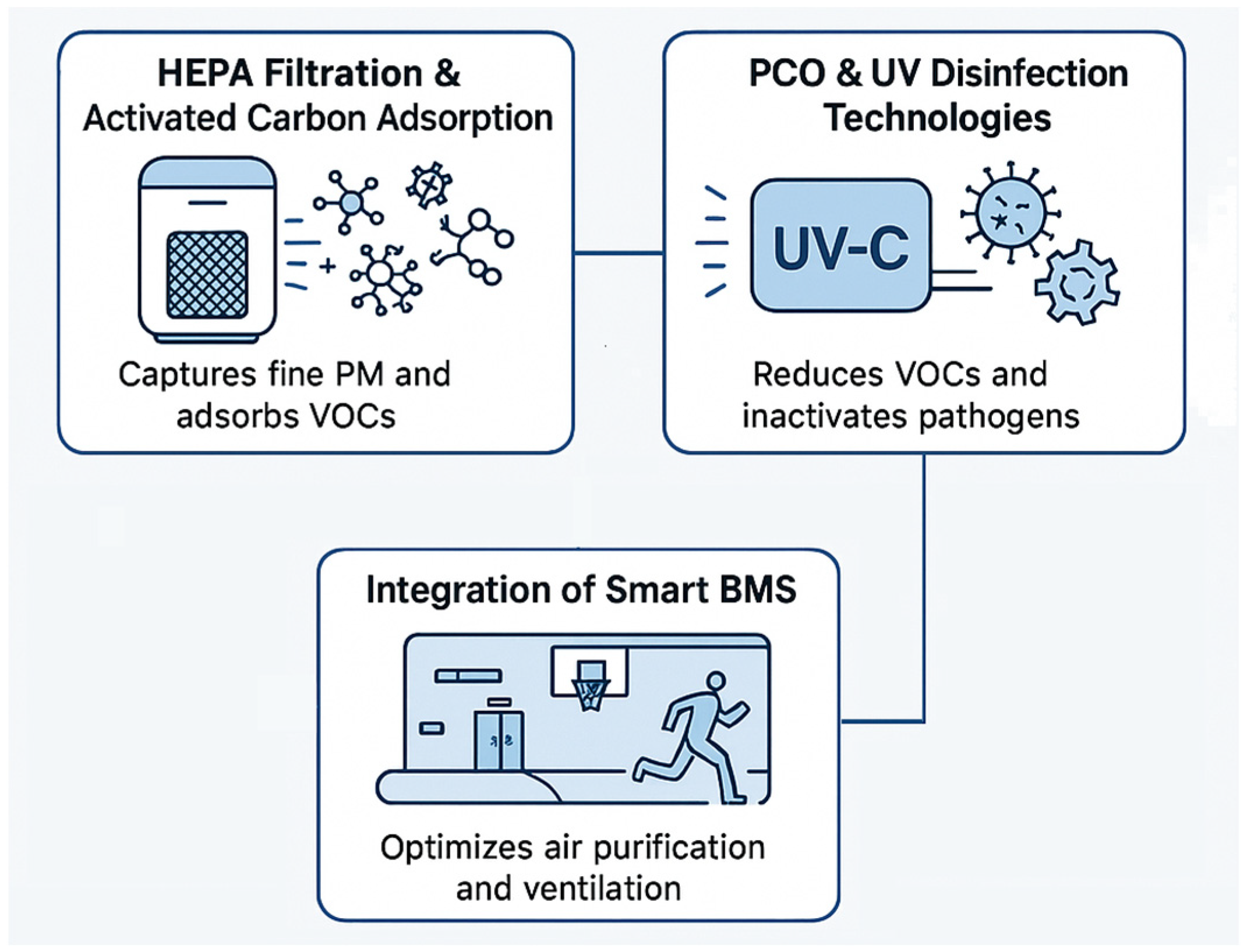
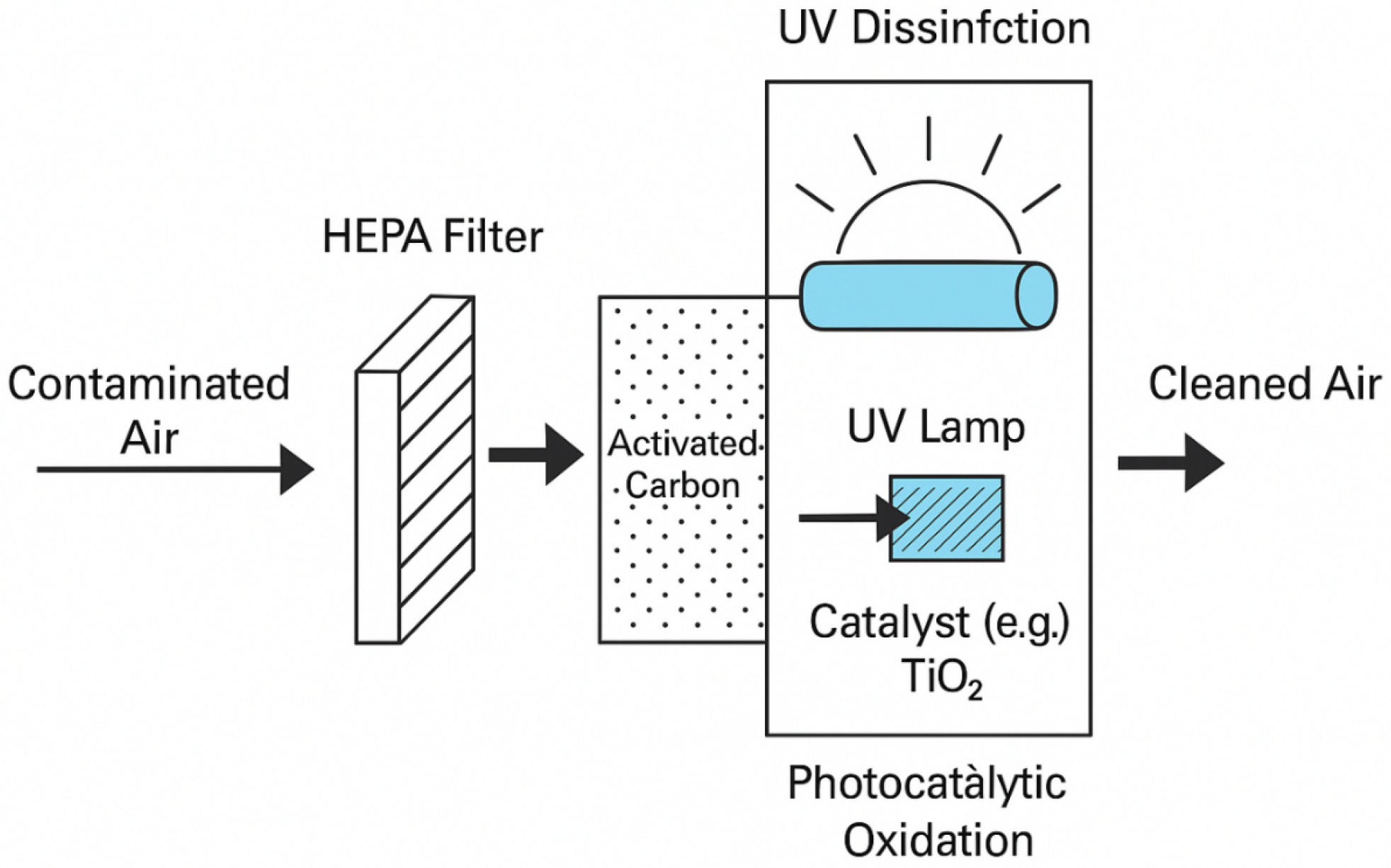
| Particle Type | Aerodynamic Diameter, µm | Typical Sources in Sports Facilities | Deposition Region in Respiratory Tract | Health Risks |
|---|---|---|---|---|
| PM10 | ≤10 | Dust resuspension, chalk powder, skin | Nasal cavity, upper respiratory tract | Irritation, coughing, asthma |
| PM2.5 | ≤2.5 | Floor abrasion, fine chalk, indoor-outdoor | Bronchi, bronchioles | Lung inflammation, reduced respiratory |
| PM1 | ≤1 | Deep chalk particles, material wear, ambient fine dust | Alveolar region | Long-term pulmonary stress, cardiovascular effects |
| UFPs | ≤0.1 | Equipment friction, HVAC byproducts, secondary reactions | May enter bloodstream and organs | Oxidative stress, neurological risks, systemic inflammation |
| VOC Compound | Typical Indoor Sources | Guideline Limit (mg/m3) | Reference | Short-Term Health Effects | Long-Term Health Risk |
|---|---|---|---|---|---|
| Formaldehyde | Plywood, foam mats, adhesives | 0.1 (WHO, GB/T 18883) | [25,56,57] | Eye/nose irritation, coughing, throat discomfort | Carcinogenicity (Group 1, IARC), asthma development |
| Benzene | Paints, rubber products, cleaning agents | ALARA (WHO); 0.11 (China) | [25,56,57] | Dizziness, headaches, respiratory irritation | Carcinogenicity (Group 1, IARC), blood disorders |
| Toluene | Solvents, disinfectants, sports equipment | 0.2 (China) | [25] | Fatigue, nausea, mucous membrane irritation | Potential liver/kidney damage, neurological effects |
| Xylene | Synthetic flooring, resins, lacquers | 0.2 (China) | [25] | Skin/eye irritation, drowsiness | Chronic respiratory symptoms, neurotoxicity |
| TVOCs (Total) | Combined emissions from materials and activities | 0.6 (China); varies internationally | [25,26,57] | General discomfort, reduced cognitive performance | Chronic exposure risks not fully defined |
| Region/ Organization | Standard/ Guideline | References | CO2 Limit Value | Averaging Time | Notes |
|---|---|---|---|---|---|
| China | GB/T 18883-2022 | [25] | ≤1000 ppm | 1-h average | Applies to general indoor environments including sports facilities |
| USA | ASHRAE Standard 62.1-2022 | [64] | ≤1000 ppm (design target) | Not strictly defined | sed as an indicator for acceptable ventilation rate (approx. 7.5 L/s·person) |
| EU | EN 16798-1:2019 (formerly EN 15251) | [27] | Category I: +350 ppm above outdoor Category II: +500 ppm Category III: +800 ppm | Instantaneous or short-term | Based on perceived air quality and comfort levels |
| WHO | WHO Guidelines for IAQ (2010) | [57] | No strict numerical limit | N/A | Recommends sufficient ventilation to maintain comfort and limit bioeffluents |
| Microbial Genus/Group | Common Sources | At-Risk Populations | Potential Health Effects | Environmental Conditions Favoring Growth | Recommended Control Measures |
|---|---|---|---|---|---|
| Staphylococcus | Human skin, nasal cavity, equipment surfaces | All users (esp. with cuts/abrasions) | Skin infections, MRSA, wound complications | High humidity, warm temperatures, skin contact surfaces | Surface disinfection, hand hygiene, proper wound care |
| Corynebacterium | Skin microbiota, sweat, shared | Athletes with sensitive skin or dermatitis | Body odor, minor infections, irritation | Sweaty, poorly ventilated areas | Regular cleaning, humidity control, fabric sanitization |
| Aspergillus | Damp materials, ventilation ducts, indoor air | Asthmatics, immunocompromised individuals | Allergic asthma, invasive aspergillosis | Damp surfaces, warm air, insufficient air exchange | Dehumidification, HEPA filtration, duct maintenance |
| Penicillium | Dust, flooring, locker room surfaces | Allergic individuals, children | Allergic rhinitis, asthma exacerbation | Moist dust, moderate humidity | Dust control, cleaning protocols, humidity balance |
| Cladosporium | Outdoor air infiltration, ventilation filters | Allergic individuals, elderly | Seasonal allergies, eye/throat irritation | Outdoor-origin spores + inadequate filtration | Improved filtration, sealing of external air leaks |
| Alternaria | Showers, wet walls, poorly ventilated spaces | Asthmatics, allergy-prone children | Severe allergic reactions, respiratory inflammation | High moisture, wet areas, poor drainage | Mold remediation, shower area ventilation, moisture control |
| Pollutant Type | Monitoring Technique | Detection Principle | Advantages | Limitations | Estimated Cost Level | Example Studies |
|---|---|---|---|---|---|---|
| PM | OPC | Light scattering from particles | Real-time, size-resolved data, compact and portable | Limited accuracy for UFPs, calibration required | Medium | [47,92] |
| PM | Gravimetric Filter Method | Mass of particles collected on filters | High accuracy, reference standard | Delayed results, manual processing, no size resolution | Low | [93] |
| VOCs | Gas Chromatography (GC/MS) | Separation and identification via retention time and mass | High specificity and compound identification | Costly, time-consuming, requires lab conditions | High | [11] |
| VOCs | PID | Ionization of VOCs by UV light | Fast, portable, detects total VOC load | Non-specific, prone to interference, needs frequent calibration | Medium | [94] |
| Microbes | Culture-based Sampling | Growth of colonies on selective media | Low cost, viable organism detection | Misses non-viable or low-abundance microbes | Low | [95] |
| Microbes | High-throughput Sequencing | DNA/RNA extraction and sequencing of microbial genomes | Comprehensive microbial profiling, detects non-culturable species | Expensive, complex data interpretation | High | [96] |
| Region/ Organization | Reference | CO2 Limit (ppm) | PM2.5 Limit (µg/m3) | Formaldehyde Limit (mg/m3) | VOC Guidance | Ventilation Rate (L/s·Person) | Monitoring/BMS Integration | Applicability to Sports Facilities |
|---|---|---|---|---|---|---|---|---|
| WHO | [57] | Not specified | 15 (annual), 25 (24 h) | 0.1 (30-min avg) | Pollutant-specific | Recommends good ventilation | Not specified | General guidance only |
| EU (EN 16798-1:2019) | [27] | +500 above outdoor (Cat II) | Not specified | Not specified | Comfort/perception driven | 7–10 | Optional | Not specifically addressed |
| China (GB/T 18883-2022) | [25] | ≤1000 (1 h avg) | 75 (24 h) | 0.1 | Benzene ≤ 0.11 mg/m3 | ~8–10 (based on building type) | Not emphasized | General public buildings, gyms included |
| USA (ASHRAE 62.1-2022) | [86] | Design target ~1000 | Not directly defined | Not specified | Controlled through dilution rates | 10–15 (gyms), varies by activity | CO2 sensors, DCV recommended | Yes (explicit occupancy/activity scaling) |
| UK (BB101, CIBSE TM40) | [97] | (CIBSE TM40) ≤ 1000–1500 | ≤10 (schools) | 0.08–0.10 (schools) | Low-emission materials encouraged | 8–10 | CO2 monitoring recommended | Yes (focus on schools, gyms, halls) |
| Technology | Target Pollutants | Advantages | Limitations | Estimated Cost Level | Reference |
|---|---|---|---|---|---|
| HEPA Filtration | PM10, PM2.5, bioaerosols | High efficiency for particulate removal; widely available | Does not remove gases or VOCs; filter replacement required | Medium | [124,125] |
| Activated Carbon Adsorption | VOCs, odors, some semi-volatile compounds | Effective for broad-spectrum VOCs and odors; low maintenance | Limited for PM or microbes; saturation over time | Low | [133] |
| UVGI | Airborne bacteria, viruses, mold spores | Strong microbial disinfection; good for humid zones | Requires safety shielding; effectiveness depends on dose and contact time | Medium-High | [131,137] |
| PCO | VOCs, some microbial degradation byproducts | Dual effect on chemicals and microbes; energy-efficient | May generate byproducts; variable effectiveness | Medium | [129] |
| Smart BMS | CO2, PM, VOCs (indirect control via system response) | Real-time monitoring and control; data-driven IAQ optimization; integration with HVAC, purification, and user feedback | High initial setup cost; depends on sensor accuracy and system integration; requires skilled operation and maintenance | High | [135] |
Disclaimer/Publisher’s Note: The statements, opinions and data contained in all publications are solely those of the individual author(s) and contributor(s) and not of MDPI and/or the editor(s). MDPI and/or the editor(s) disclaim responsibility for any injury to people or property resulting from any ideas, methods, instructions or products referred to in the content. |
© 2025 by the authors. Licensee MDPI, Basel, Switzerland. This article is an open access article distributed under the terms and conditions of the Creative Commons Attribution (CC BY) license (https://creativecommons.org/licenses/by/4.0/).
Share and Cite
Cao, X.; Fang, H.; Yuan, X. Toward Health-Oriented Indoor Air Quality in Sports Facilities: A Narrative Review of Pollutant Dynamics, Smart Control Strategies, and Energy-Efficient Solutions. Buildings 2025, 15, 3168. https://doi.org/10.3390/buildings15173168
Cao X, Fang H, Yuan X. Toward Health-Oriented Indoor Air Quality in Sports Facilities: A Narrative Review of Pollutant Dynamics, Smart Control Strategies, and Energy-Efficient Solutions. Buildings. 2025; 15(17):3168. https://doi.org/10.3390/buildings15173168
Chicago/Turabian StyleCao, Xueli, Haizhou Fang, and Xiaolei Yuan. 2025. "Toward Health-Oriented Indoor Air Quality in Sports Facilities: A Narrative Review of Pollutant Dynamics, Smart Control Strategies, and Energy-Efficient Solutions" Buildings 15, no. 17: 3168. https://doi.org/10.3390/buildings15173168
APA StyleCao, X., Fang, H., & Yuan, X. (2025). Toward Health-Oriented Indoor Air Quality in Sports Facilities: A Narrative Review of Pollutant Dynamics, Smart Control Strategies, and Energy-Efficient Solutions. Buildings, 15(17), 3168. https://doi.org/10.3390/buildings15173168






